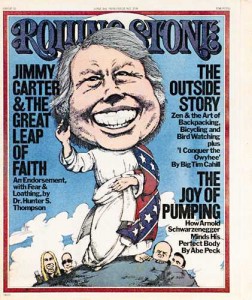Rolling Stone #214: Led Zeppelin
Zeppelin’s Presence’
Secrets of the Object Concealed
New York – Led Zeppelin’s Presence is currently the Number One album in the country, but people are still speculating about its mysterious focal point, the small black monolith that dominates the album’s slightly surreal packaging. Mixed in, on and about the 1950 Life and Look magazine photos of middle America, the figure is referred to only as “The Object.” But street rumors have described it as everything from the new Zeppelin logo to a black-magic worship piece. Radio stations and record stores have even started guessing contests.
Nobody at the New York office of Zeppelin’s Swan Song Records had any idea what “The Object” symbolizes. And at Swan Song’s London office, Zeppelin caretaker Richard Cole had “no idea whatsoever” what it means. “And it’s not bothering me at all,” he said, laughing. “I’m not even sure they know.” Cole then clamped his hand over the receiver. A moment later, he returned. “Hold on for Robert.”
Though he’s still recuperating from the car accident that shattered his right ankle last year, Plant sounded even more boisterous than usual. “I feel great,” Plant chirped. “I’ve been living on the side of a mountain in a Moroccan tent. I get quite stiff at times, but it’s been great for the leg.”
All well and good. But what about “The Object”?
“This is great,” he exclaimed. “I’m glad people are wondering what it means. The most I can say, though, is that everybody should work it out for themselves. Come on, it’s not that hard to figure out…especially for our more Kubrickian fans.”
Plant’s remark seemed a clue that “The Object” is Zeppelin’s miniature, modified (slightly twisted, and with a base) version of the monolith featured in 2001: A Space Odyssey. But Aubrey Powell, the album’s British designer, has said that he “didn’t think of that. I don’t want to give an explanation because it doesn’t need one. I just had a tremendous feeling when I went to Zeppelin that this was absolutely right at this particular moment for them.”
Now Plant became equally inscrutable. “Whatever you want it to say, it says. ‘The Object’ can be taken in many ways. Let’s just say that we love plucking these little niceties out there. We used symbols [sort of cosmic hieroglyphics] on the four album too. They’re fun and they only add to the music. But there’s not much fun in knowing everything, is there?” So now you know.
Courtesy of Rolling Stone #214 – Cameron Crowe – June 3, 1976


